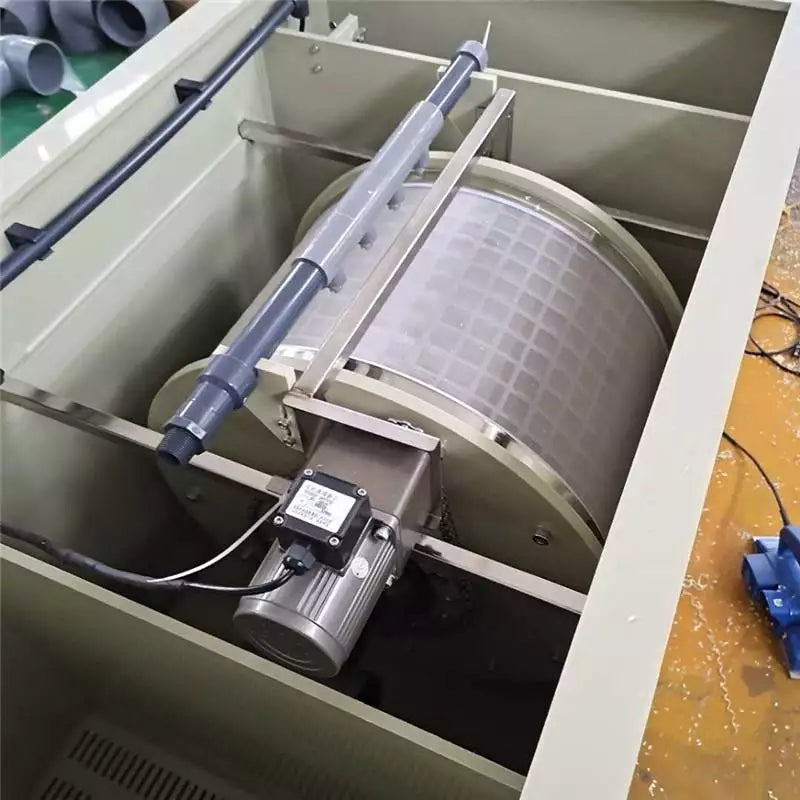
How Does A Drum Filter Work?
Share
Drum Filter: Principles and Applications
Introduction to the Drum Filter
The Drum Filter is a widely used device in the field of water and wastewater treatment. It can effectively remove suspended solids, solids and other impurities to ensure clean water. In this paper, we will discuss in detail the working principle, structure, advantages and disadvantages of Drum Filter, as well as its applications in various fields.
Working Principle
The basic working principle of the drum filter is to use physical filtration to remove solid particles from water. Its main structure consists of a rotating cylinder (drum), which is covered with a fine filtering medium. When the sewage enters the interior of the drum, the surface of the rotating drum forms a filter layer under the action of the water flow. Suspended matter is retained on the filter media, while clear water flows out through the filter media.
Water inlet stage: Sewage flows into the interior of the drum filter through the water inlet. The speed and flow rate of the water is designed to ensure optimal filtration.
Filtration phase: The rotation of the drum brings the filter media into contact with the effluent, physically retaining solid particles. As filtration proceeds, dirt accumulates on the surface of the drum, forming a filter layer.
Cleaning stage: when the filter layer reaches a certain thickness, the filter will automatically start the cleaning program. Usually backwashing or spray cleaning is used to rinse off the solid particles attached to the filter media and discharge them.
Structure
The main structure of drum filter includes the following parts:
Drum body: usually made of stainless steel or plastic, with good corrosion resistance and mechanical strength.
Filter media: can be metal mesh, polyester fiber or other synthetic materials, pore size according to the requirements of the treated water quality.
Driving system: usually driven by an electric motor to ensure stable rotation of the drum.
Cleaning system: including pumps and nozzles for regular cleaning of the filter media.
Advantages and disadvantages
Advantages
High-efficiency filtration: drum filters can effectively remove a variety of solid particles and are suitable for different water qualities.
High degree of automation: modern drum filters are usually equipped with automatic cleaning and monitoring systems, reducing the need for manual operation.
Small footprint: compared with traditional sedimentation tanks, drum filters are smaller in size and suitable for sites with limited space.
Simple maintenance: the design of the filter makes it relatively simple to maintain and replace the filter media.
Disadvantages
Higher initial investment: Drum filters are more expensive to purchase and install, which may be a burden for small businesses.
Higher water quality requirements: In some cases, poor quality of incoming water may affect filtration results and lead to frequent cleaning.
Problems with energy consumption: although the energy consumption of modern filters has been reduced, the impact of energy consumption still needs to be considered in some applications.
Areas of application
Drum filters are widely used in a number of applications, including:
Municipal water treatment: used in the treatment of tap water and sewage to ensure that the water quality meets the standard.
Industrial wastewater treatment: in chemical and pharmaceutical industries, it is used to remove solid impurities in wastewater.
Aquaculture: In aquaculture, to keep the water clean and promote the healthy growth of fish.
Food Processing: In food production, to ensure clean water quality and meet hygiene standards.
Conclusion
As an efficient water treatment equipment, drum filter has become an important part of the modern water treatment field by virtue of its excellent filtration performance and automation characteristics. Although there are some limitations, its wide application in various fields proves its value. With the continuous progress of technology, the drum filter will continue to promote the development of water treatment technology in the future and contribute to the sustainable utilization of water resources.
